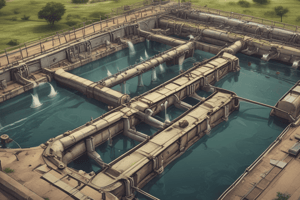Podcast
Questions and Answers
What is the primary method used in primary treatment for the removal of solids?
What is the primary method used in primary treatment for the removal of solids?
- Physical separation (correct)
- Biological filtration
- Aerobic digestion
- Chemical reactions
In the secondary treatment process, what is primarily converted into CO2 and NH3?
In the secondary treatment process, what is primarily converted into CO2 and NH3?
- Organic matter (correct)
- Suspended solids
- Nitrogen compounds
- Heavy metals
What is the main outcome of tertiary treatment in water treatment processes?
What is the main outcome of tertiary treatment in water treatment processes?
- Chlorination of effluent (correct)
- Introduction of heavy metals
- Reduction of water temperature
- Oxygen depletion
What percentage of suspended solids (SS) does secondary treatment typically remove?
What percentage of suspended solids (SS) does secondary treatment typically remove?
What is the fate of sludge produced in the treatment process?
What is the fate of sludge produced in the treatment process?
How much phosphorus (P) is typically removed during the treatment process?
How much phosphorus (P) is typically removed during the treatment process?
What is one of the final steps before the effluent is discharged back to the stream?
What is one of the final steps before the effluent is discharged back to the stream?
What happens to ammonia (NH3) during the secondary treatment phase?
What happens to ammonia (NH3) during the secondary treatment phase?
Which treatment stage is primarily responsible for achieving a removal efficiency of >90% for BOD?
Which treatment stage is primarily responsible for achieving a removal efficiency of >90% for BOD?
In terms of nutrient removal, what stage is critical for handling nitrogen?
In terms of nutrient removal, what stage is critical for handling nitrogen?
Flashcards are hidden until you start studying
Study Notes
Wastewater Management Overview
- Wastewater from toilets and washers flows by gravity to local wastewater treatment plants.
- Over 80% of the world's wastewater is untreated, highlighting a critical global issue.
Wastewater Treatment Goals
- Improve wastewater quality through technological applications.
- Reduce organic matter content (Biochemical Oxygen Demand - BOD).
- Remove nutrients like nitrogen (N) and phosphorus (P) to prevent pollution in water bodies.
- Inactivate pathogenic microbes and parasites.
Primary Treatment
- A mechanical process that includes:
- Screening to remove large debris.
- Grinding to reduce particle size.
- Grit chambers to settle heavy particles.
- Sedimentation tanks for suspended solids, generating sludge.
- Results in liquid-solid separation but does not purify sewage.
Secondary Treatment
- Involves biological processes using bacteria to further reduce organic waste and lower BOD.
- Types include:
- Trickling Filters: Effluent flows through a medium where aerobic bacteria break down waste.
- Activated Sludge: Aeration tanks that promote microbial digestion.
Septic Systems
- Septic tanks are typically three-chambered systems:
- Suspended solids settle to create sludge.
- Sludge is periodically pumped out for disposal.
- Effluent flows into leaching fields for microbial decomposition.
Tertiary Treatment
- Final stage of treatment focusing on disinfecting treated sewage.
- Often involves chlorination to eliminate pathogens before discharge to water bodies.
- Advanced treatments may include UV light, achieving water purity suitable for drinking.
Oxidation Ponds
- Inexpensive wastewater treatment but requires large land areas.
- Two stages: first for sedimentation and second to aerate and promote aerobic bacterial growth using wave action.
- Algae in ponds utilize carbon dioxide during photosynthesis, enhancing oxygen levels for decomposition.
Treatment Efficiency Levels
- Primary Treatment:
- Removes 50-80% of suspended solids (SS).
- Reduces BOD by 20-40% using physical separation.
- Secondary Treatment:
- Achieves 80-90% removal of SS and 70-90% reduction in BOD.
- Tertiary Treatment:
- Over 90% removal of SS and BOD, with nutrient removal efficiencies for phosphorus (P) at 90%.
Output Management
- Treated effluent undergoes final carbon filtration and chlorination before returning to natural water systems.
- Nutrient-rich sludge can be:
- Applied as fertilizer.
- Incinerated as fuel after drying.
- Composted for organic matter recycling.
Studying That Suits You
Use AI to generate personalized quizzes and flashcards to suit your learning preferences.




